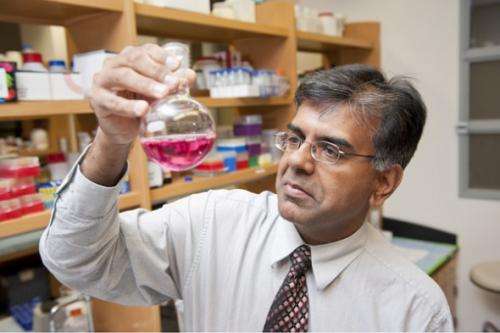Kryptonite for cancer cells

(Phys.org) —Every available cancer drug is susceptible to resistance, according to Mansoor Amiji, Distinguished Professor and chair of the Department of Pharmaceutical Sciences. Tumors grow more quickly than blood vessels, so these unruly masses of cells receive very little oxygen and nutrients, which means they know just how to survive under harsh conditions. They make miniature pumps to actively dispel anything that doesn't serve them well (like drugs), and they evade all the checks and balances that normally maintain healthy cell populations.
Each of these supercell powers is coded in the cancer's DNA. In theory, turning off the right genes would turn off the superpowers, according to Amiji. A method called RNA interference does exactly that. By inhibiting protein production of specific sections of DNA, so-called small interfering RNA, or siRNA, can shut down the activity of individual genes.
But this is easier said than done. The siRNA molecules are incredibly finicky molecules, which Amiji likened to a picky houseguest who needs everything just so. "They're small, negatively charged, and extremely labile," he said, and they degrade if you so much as breathe on them in the lab. All of these characteristics make it difficult to get them where you want them inside the body.
In a recent paper in the journal Biomaterials, Amiji and collaborators at Novartis Institutes for Biomedical Research present a system that they believe will overcome some of these challenges. Using their expertise in targeted drug delivery, Amiji's team developed a modular system that can be used to deliver siRNA and any standard drug directly to the cancer cells and nowhere else. This work is funded by the National Cancer Institute's Alliance for Nanotechnology in Cancer Platform Partnership grant.
"If we really want to take resistance head on, we need to address it in a multifactorial way," said Amiji. The new modular system is just that—a multifaceted approach that simultaneously addresses chemo toxicity and resistance, two of the most difficult challenges facing cancer drug developers.
In the research, spearheaded by Amiji's former graduate student Shanthi Ganesh and current research assistant professor Arun Iyer, the team created a library of carrier complexes, each specialized for certain properties. Some of the complexes are good at carrying negatively charged molecules (like siRNA) through the negatively charged cell membrane, which normally repels them. Other complexes are good at engulfing hydrophobic drugs (which don't dissolve in water), while still others work better with hydrophilic, or
water-loving," drugs.
"It's almost like Lego pieces that you can mix and match to create the right assembly for the right type of payload, and then subsequently target the right area of the body where it needs to be delivered," said Amiji.
The assemblies also dawn molecules that make them act like homing-pigeons in the blood, carrying their messages of cellular destruction to cancer cells alone.
In this research, Amiji's team focused on a molecule called hyaluronic acid, which many cancer cells recognize via specialized receptors on their surface. In the lab, they were able to design systems that delivered drugs and siRNAs directly and solely to cancer cells, wherein 100 percent of the payload was released.
But once they tested the process in live mice, they had less success. That's because two factors that help ensure the complexes will reach their target aren't an issue in the petri dish: plumbing and instructions. If the targeted cancer cells have too few receptors on their surface, the complexes won't find them in the relatively enormous organismal system. But even if receptor expression is high, blood supply must also be high in the live mouse, or they won't even begin their journey in the first place.
Future researchers will need to balance these factors when using the team's library to develop carriers appropriate for specific drugs and cancer types, Amiji said. But the modularity of their system makes it especially well-suited to deal with a variety of unique challenges. "It allows us to customize this system for the right type of tumor," he explained.
More information: www.sciencedirect.com/science/ … ii/S014296121300118X
Journal information: Biomaterials
Provided by Northeastern University














